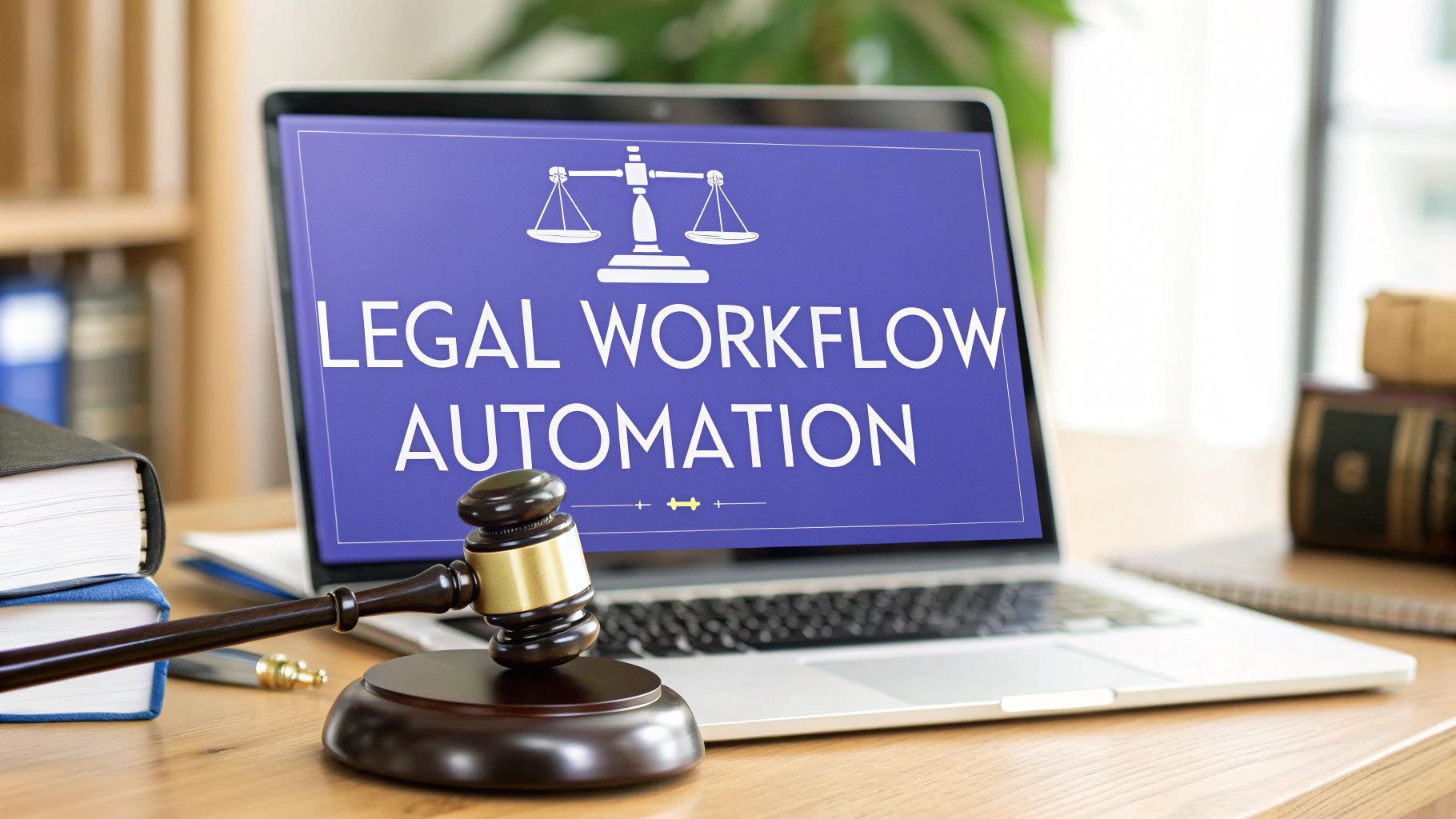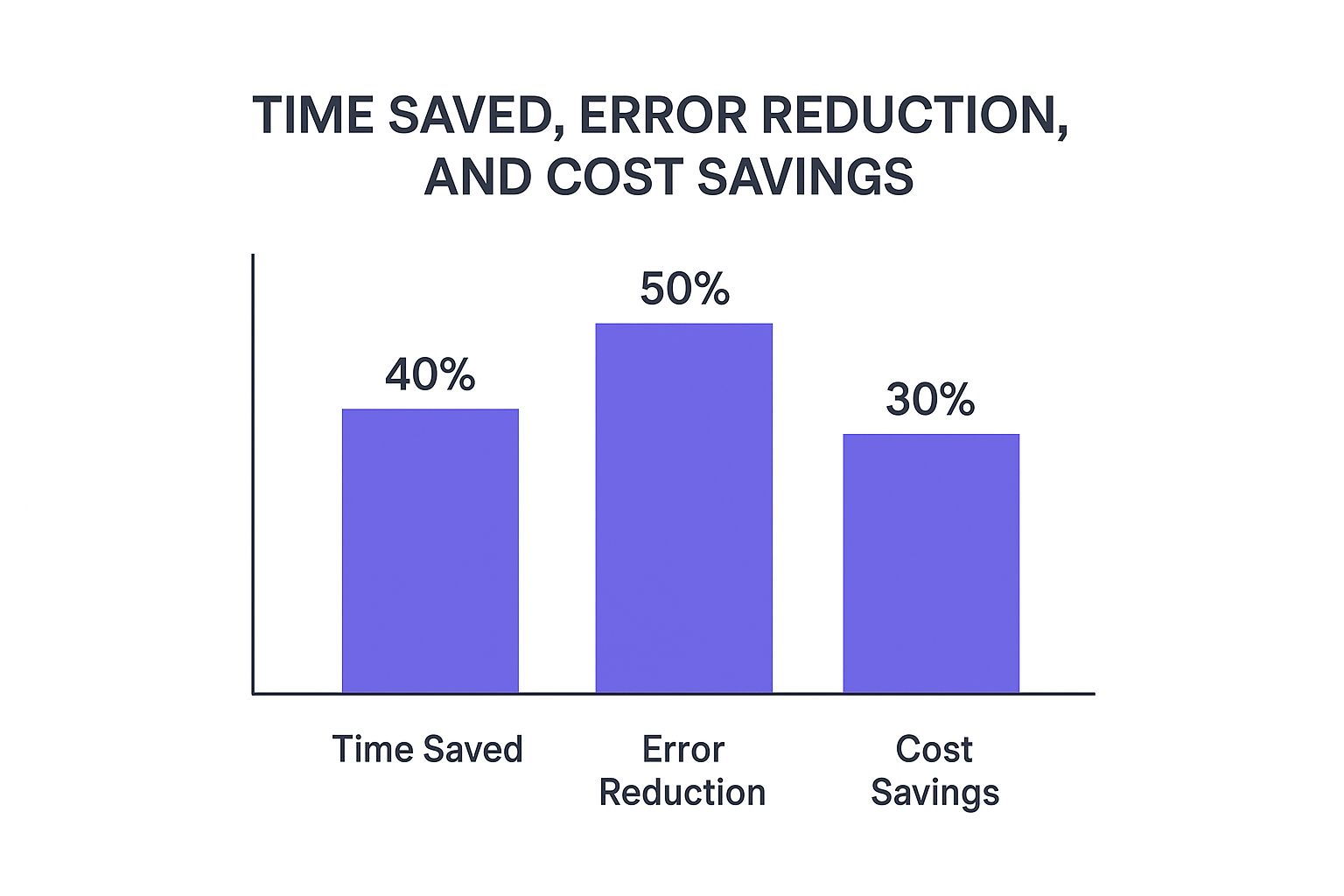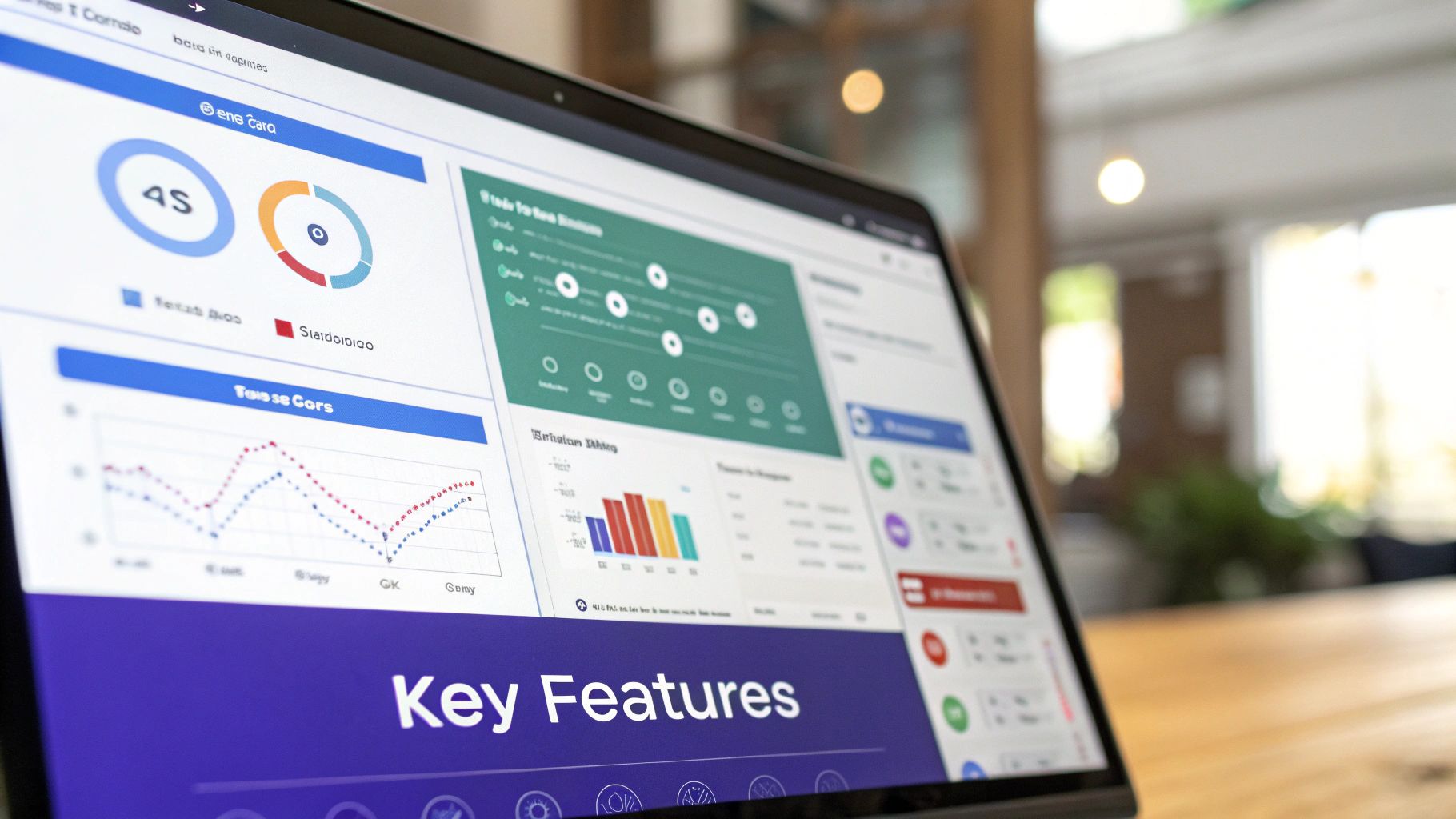
Getting Started With Legal Workflow Automation

Managing a law practice often involves juggling numerous responsibilities. Client communications, document preparation, and court deadlines can be overwhelming to handle manually. Legal workflow automation offers a way to make your practice more efficient. This approach empowers legal professionals to focus on their core expertise, not administrative tasks.
Identifying Automation Opportunities
The first step is identifying processes that consume excessive time and resources. Consider repetitive tasks that detract from billable work. For example, are you spending hours drafting similar documents, scheduling meetings, or sending follow-up emails? These are ideal candidates for automation.
Also, consider tasks prone to human error, like data entry or document review. Automation can significantly reduce these errors, improving accuracy and minimizing corrections.
Overcoming Automation Fears
Many firms hesitate to adopt automation due to concerns about cost, complexity, and control. However, many affordable automation solutions are available for small and medium-sized firms. You can start small, automating a few key processes, and expand as needed. Modern tools also allow you to maintain control while delegating routine tasks to the system.
In recent years, legal workflow automation has demonstrably improved law practice efficiency. By automating routine tasks, firms have increased billable hours, client satisfaction, and profitability. In 2023, lawyers at small firms reported spending 61% of their time on billable work, up from 56% the previous year.
This shift has generated significant revenue gains. Firms using tools like online intake forms and e-signatures report up to 20% higher revenue and 15% faster client onboarding. For more detailed statistics: Learn more about Legal Workflow Automation Statistics
Starting Small and Scaling Up
Implementing legal workflow automation doesn't require a complete system overhaul. Start with a single, high-impact process, such as client intake. Automating this can streamline initial client engagement, saving time and ensuring consistent data collection.
After seeing the benefits, you can gradually expand automation to other areas like document management, billing, or even legal research. This gradual approach allows you to refine your strategy while minimizing disruption. It also allows your team to adapt to the new technology smoothly.
Why RPA Is Revolutionizing Legal Services Right Now

The infographic above highlights the potential of automating legal workflows. It demonstrates how firms can save time, reduce errors, and lower costs. The data reveals impressive potential improvements: a 50% decrease in errors, a 40% increase in time saved, and 30% in cost savings.
Integrating Robotic Process Automation (RPA) is key to achieving these results. These efficiencies allow legal professionals to dedicate more time to complex tasks, ultimately benefiting clients and boosting profitability.
Understanding the Power of RPA
RPA is changing the legal field, providing a real advantage for firms that adopt it. Unlike simpler automation tools, RPA uses software "robots" to manage complex, multi-step processes. These processes usually require human input.
This means tasks like document review, contract analysis, and due diligence can be handled more efficiently and accurately. This is particularly important in law, where precision and efficiency are essential.
Legal Processes Benefiting From RPA
Many legal processes see a substantial return on investment with RPA. Think about legal research, which often means combing through numerous documents and databases. RPA can automate this, quickly finding relevant precedents and case law. This saves lawyers valuable time.
RPA also excels at tasks like document assembly and e-discovery. It automates repetitive actions and minimizes the risk of human error.
The use of RPA in legal services is growing rapidly. The global market is expected to reach USD 13.09 billion by 2034. It's projected to grow at a CAGR of 17.14% from 2025. For more statistics, check out this resource: Explore the RPA Market Growth
Evaluating RPA Opportunities in Your Practice
To find RPA opportunities in your own practice, analyze your existing workflows. Look for tasks that are:
- Repetitive and rule-based
- High-volume and time-consuming
- Prone to human error
For instance, if client intake and onboarding take up significant time, RPA can automate data entry and form processing. This speeds up the whole process. By strategically targeting these tasks, you can maximize the benefits of legal workflow automation. You can also significantly improve your firm's efficiency and profitability.
Making AI Work For Your Legal Practice

Artificial intelligence (AI) isn't about replacing lawyers. It's about giving them better tools. AI improves legal workflow automation, freeing lawyers from tedious tasks so they can concentrate on strategy and client relationships. This translates to more time for critical thinking and less time on repetitive administrative duties.
Practical Applications of AI in Law
AI tools are already impacting legal practices. For instance, AI can draft initial versions of legal documents, significantly reducing drafting time. AI can also generate correspondence, freeing up hours previously spent on routine emails and letters. These practical applications boost firm efficiency without compromising quality.
The legal industry is increasingly adopting AI, significantly affecting legal workflow automation. A survey of over 2,800 legal professionals found that 54% use AI for drafting correspondence and 47% for other tasks. 31% reported using generative AI, an increase from the previous year. For more detailed information, check out this resource: Explore AI Adoption in Law.
Balancing AI Efficiency With Ethical Responsibilities
AI offers clear advantages, but ethical considerations are crucial. Successful firms understand the importance of balancing efficiency and professional responsibility. This includes carefully checking the accuracy of AI-generated content and establishing best practices for its use.
Addressing Concerns and Hesitations
Many legal professionals have concerns about AI, from accuracy and data security to the changing legal profession. By addressing these concerns and establishing clear guidelines, firms can integrate AI responsibly, maintaining ethical standards.
This proactive approach builds trust and ensures responsible AI use. It allows firms to use AI for a competitive advantage while upholding client trust and professional integrity. Responsible implementation makes AI a powerful tool for the modern legal practice.
Choosing The Right Legal Workflow Automation Tools
After understanding the advantages of legal workflow automation, AI, and RPA, selecting the right tools is paramount. With a multitude of options available, informed decisions are key to successful implementation. This involves carefully evaluating your firm's specific needs, size, and areas of practice.
Essential Categories of Legal Workflow Automation Tools
Several software categories are crucial for legal workflow automation. Client intake systems automate the initial consultation and data collection process. Case management platforms offer centralized storage for case files and deadline tracking. Document automation software simplifies document creation and revisions. Billing and time-tracking tools automate invoice generation and payment processing.
Avoiding Implementation Pitfalls
Adopting too many new tools simultaneously is a common mistake. It's best to start with one or two key areas, such as client intake or document automation. Another pitfall is overlooking integration capabilities. Ensuring your chosen tools integrate seamlessly with existing systems is crucial to prevent data silos and workflow disruptions. For more information on document management, check out this helpful resource: How to master legal document management.
Key Features to Consider
When selecting tools, consider these essential features. Look for customizable templates and workflows adaptable to your firm's processes. Robust reporting and analytics features provide valuable data on performance and ROI. Secure data storage and compliance with legal regulations are essential. User-friendly interfaces and reliable customer support ensure smooth adoption and ongoing success.
Evaluating Integration Capabilities
Thoroughly assess a tool's integration capabilities with your existing software before committing. For instance, confirm that your chosen case management system integrates seamlessly with your document automation software. Seamless integration is essential for efficient data flow and eliminates manual data entry, which minimizes errors and saves valuable time. This is also important for maximizing efficiency and preventing workflow disruptions.
Managing Costs and Maximizing ROI
While cost is a consideration, focus on the potential return on investment (ROI). Calculate potential time savings, error reduction, and revenue growth. Factor in the long-term benefits of improved client satisfaction and employee morale, contributing to a more sustainable and thriving practice.
To help you compare available solutions, we've compiled the following table:
Introduction to the Legal Workflow Automation Tools Comparison Table:
The table below offers a concise overview of various legal workflow automation tools, highlighting their key features, ideal use cases, integration options, and pricing structures. This information can aid in selecting the most suitable tool for your firm's specific needs.
| Tool Category | Key Features | Best For | Integration Options | Price Range |
|---|---|---|---|---|
| Client Intake Systems | Automated questionnaires, e-signatures, CRM integration | Solo practitioners, small firms | CRM, practice management software | $20-$100/month |
| Case Management Platforms | Centralized file storage, deadline tracking, task management | Small to medium-sized firms | Document automation software, billing software | $50-$200/month |
| Document Automation Software | Customizable templates, automated workflows, e-signatures | All firm sizes | Case management platforms, e-signature software | $30-$150/month |
| Billing and Time-Tracking Tools | Automated invoice generation, payment processing, expense tracking | All firm sizes | Accounting software, practice management software | $15-$75/month |
Conclusion of the Legal Workflow Automation Tools Comparison Table:
As the table demonstrates, various tools cater to different needs and budgets. Carefully consider your firm's specific requirements and explore available integrations to maximize efficiency and ROI. Choosing the right tools can significantly enhance productivity and streamline operations.
Implementing Legal Workflow Automation That Sticks

Having the best legal workflow automation software doesn't guarantee success. True success comes from effective implementation and team adoption. This involves understanding your firm's specific needs and creating a strategy that gets everyone on board. This section explores how to introduce legal workflow automation smoothly and efficiently.
Conducting Effective Workflow Audits
Before introducing any new technology, understand your current processes. A thorough workflow audit reveals inefficiencies and pinpoints areas ready for automation. This means mapping out each step of your existing workflows, from initial client contact to case completion.
For example, document the time each task requires, who's in charge, and where delays happen. This analysis offers valuable data on which processes will benefit most from automation.
It also helps determine which areas to tackle first.
Prioritizing Automation Opportunities
Not every process is the same. Concentrate on automating high-volume, repetitive tasks that use up considerable time and resources. This might include client intake, document creation, or appointment scheduling.
Prioritizing these areas delivers the biggest initial gains and lets your team handle more important work. Automating client intake, for example, can lighten administrative work, allowing your team to concentrate on client interaction and case strategy. This smart approach ensures quick wins and shows the value of automation. You might be interested in: How to master legal document automation.
Engaging Your Team and Managing Change
Successful implementation means involving your team from the outset. Explain the advantages of automation clearly and address any worries. This includes sufficient training and support to ensure a smooth change.
This proactive approach minimizes pushback and encourages a positive response to the new technology. It also helps create a culture of ongoing improvement.
Overcoming Implementation Challenges
Automation projects often face obstacles. Resistance to new methods, data security worries, and regulatory requirements can all hinder implementation. Tackling these problems directly is key.
For instance, clearly explaining data security measures and showing compliance with rules helps build trust and eases concerns.
Timeline Frameworks and Milestone Tracking
Creating a practical timeline with defined milestones keeps projects moving forward. Divide the implementation process into smaller steps with specific deadlines. Regularly monitor progress and acknowledge achievements.
This organized method provides a sense of progress and keeps up the energy. Tracking milestones also helps identify potential problems early and allows you to adapt your plan. This makes sure your automation initiatives deliver lasting value and truly improve your practice.
Proving Your Legal Workflow Automation Investment Pays Off
Implementing legal workflow automation requires an investment, and demonstrating a return on that investment is crucial for continued support and expansion. This means tracking the right metrics and effectively communicating their impact to stakeholders. This section explores how successful firms measure and communicate the real impact of their automation investments.
Measuring the Tangible and Intangible
The most obvious benefits of automation are often quantifiable, such as time savings. If document automation software reduces document drafting time by 50%, that translates directly into increased billable hours or reduced overhead. You might be interested in: How to master automated contract analysis. However, don't overlook the less obvious but equally important intangible benefits. Improved client satisfaction, resulting from faster response times and increased communication, can lead to increased client retention and referrals.
Additionally, streamlined workflows can improve employee morale and reduce burnout, positively impacting employee retention. These intangible benefits, while harder to quantify, contribute significantly to a firm's overall success.
Establishing Meaningful Baselines
Before implementing automation, establish clear baseline measurements. Track the time spent on key processes, the frequency of errors, client satisfaction scores, and employee turnover rates. This data will serve as a benchmark against which to measure the impact of your automation initiatives. For example, if your current client intake process takes an average of two hours, track this metric after implementing automation to quantify the time saved. This allows you to demonstrate concrete improvements.
Tracking Progress and Presenting Results
Regularly monitor key performance indicators (KPIs) and present the results in a way that resonates with stakeholders. Focus on metrics that matter to your firm's leadership, such as increased revenue, reduced costs, and improved efficiency. Visual representations, like charts and graphs, can effectively communicate the impact of automation. A clear, concise presentation of data is more compelling than raw numbers alone.
To illustrate the impact of legal workflow automation, consider the following table showcasing potential ROI metrics:
Introducing the table below, we can see some example metrics used to measure the ROI of legal workflow automation.
| Metric Category | Specific KPIs | Measurement Method | Target Improvement | Timeframe |
|---|---|---|---|---|
| Efficiency | Document Drafting Time | Time Tracking Software | 50% Reduction | 6 Months |
| Cost Reduction | Overhead Expenses | Financial Reports | 20% Reduction | 1 Year |
| Client Satisfaction | Client Surveys | Post-Project Surveys | 15% Increase | 1 Year |
| Employee Morale | Employee Surveys | Anonymous Surveys | 25% Improvement | 6 Months |
| Revenue | Billable Hours | Time Tracking Software | 20% Increase | 1 Year |
This table demonstrates how specific KPIs, measurement methods, target improvements, and timeframes can be established to track the ROI of legal workflow automation initiatives. By consistently monitoring and reporting on these metrics, firms can demonstrate the value of their automation investments.
Industry Benchmarks and Continuous Improvement
Research industry benchmarks for automation ROI to see how your firm compares. This information can help identify areas for improvement and set realistic goals. Legal workflow automation isn't a one-time fix; it requires continuous monitoring and adjustment. Regularly review your workflows and identify areas for further optimization. This ongoing process ensures that your systems continue to deliver value long after implementation. By consistently analyzing performance data and seeking ways to refine your processes, you can maximize the long-term benefits of legal workflow automation.
Building A Future-Ready Legal Practice Through Automation
The legal field is constantly evolving, and staying ahead requires embracing innovation. This means understanding and implementing strategies that will stand the test of time, especially regarding legal workflow automation. Let's explore how successful firms are preparing for the future of legal tech and maintaining their competitive edge.
Emerging Trends in Legal Workflow Automation
Several key trends are shaping the future of legal workflow automation. Blockchain technology, for example, offers secure and transparent record-keeping, potentially revolutionizing contract management and evidence handling. Blockchain coupled with advanced AI and predictive analytics, is enabling more sophisticated automation of tasks like legal research and document review. These advancements are not just about improving efficiency; they're fundamentally reshaping how legal work gets done.
Preparing for Integration With New Technologies
Forward-thinking firms are already preparing for these changes. They are actively evaluating how blockchain, advanced AI, and predictive analytics can integrate with their current systems. This involves researching potential applications, conducting pilot tests of new technologies, and building relationships with innovative vendors. Furthermore, successful firms are investing in training and development to equip their teams with the skills they need to use these new tools effectively. This proactive approach allows them to adapt quickly to the changing legal tech landscape.
Building Sustainable Competitive Advantages
Adopting new technologies is essential, but a true competitive advantage comes from strategic implementation. Firms need to develop internal capabilities that support long-term growth. This includes building robust data management strategies, fostering a culture of innovation, and prioritizing cybersecurity. For instance, training employees to use data analytics (Tableau) to improve workflow efficiency can yield valuable insights that enhance client service and set a firm apart.
Scaling Automation Investments
As firms grow, their automation needs evolve. Scalability is a key factor to consider when choosing and implementing automation tools. This means selecting platforms that can handle increasing amounts of data and user demands. It also involves evaluating the potential for integration with other systems as the firm expands its operations. A small firm might initially use a basic client intake system, but a larger firm might require a more robust platform that integrates with CRM (Salesforce) and case management software. Planning for scalability from the start can help avoid expensive system migrations in the future.
Maintaining Strong Vendor Relationships
Technology partnerships are essential for successful legal workflow automation. Maintaining strong relationships with your tech vendors is crucial. This requires open communication, regular feedback, and a collaborative approach to problem-solving. Strong vendor relationships ensure your firm has access to the latest updates, training, and support, maximizing your tech investments. This proactive approach helps you derive the most value from your automation tools.
Positioning Your Firm for Sustained Success
The legal landscape is changing rapidly, but firms can prepare for the future by strategically embracing automation. By staying informed about emerging trends, investing in new technologies, and building internal capabilities, firms can position themselves for lasting success. Prioritizing ethical considerations and responsible implementation of these technologies will be crucial for maintaining client trust and navigating the evolving legal landscape. This proactive strategy will allow firms not only to survive but also to thrive in the future of law.
Ready to streamline your workflow? Learn more about how Legal Document Simplifier can help you stay ahead of the curve by visiting Legal Document Simplifier.